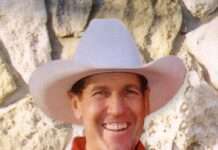It’s doubtful that anyone in Lawrence worries over the water supply in Hays or cattle prices in Dodge City ‒ at least not in the way they tune in to Kansas City. And yet liberal Lawrence, a leafy university town, is bound to the arid west by shotgun marriage, carved by gerrymander into the vast, rural and mostly conservative First Congressional District.
This merger takes in 400 miles of politics, culture, lifestyle and landscape, east to west.
Lawrence, home to the University of Kansas, bustles in the hills and woods along the wide Kansas River. Here is land of the southern Osage Questas, fed and watered by the many creeks and tributaries of the western High Plains and Smoky Hills.
Dodge City lies along the Ark River lowlands and High Plains, its high plateaus, dry streambeds, grassy humpbacks and tableland to the horizon.
Lawrence is inclined to the metropolitan east, drawn to the urban hives, their energy and movement, their sociability, their congestion. The western townships struggle against an exodus of people as farm cities look for affordable housing and bi-lingual school teachers ‒ tri-lingual, if they’re lucky.
In spite of the contrasting landscapes, divergent lifestyles and disparate cultures, east and west in Kansas share a long list of connective concerns. They include schools, health care, local taxes, the environment and more. Each of these mutual concerns is subverted by the meddling politics of Topeka.
Consider two of them. Health care and local taxes are genuine worries shared across Kansas, east to west. In Topeka, they are merely cornerstones for the grievance-dogma of cause lobbies, local issues nationalized and fortified with outside money.
*
Head west from Lawrence (pop. 95,000) and the vista gets bigger and the cities smaller. Along the Interstate it’s 85 miles to Manhattan (55,000), another 55 miles to Salina (46,500). Hays (21,000) is another 100 miles. Two-lane highways southwest another 112 miles to Dodge City (28,000), west 52 miles to Garden City (28,000), then south 72 miles to Liberal (19,600) ‒ 476 miles west as the roads go, not as the crow flies.
It’s about the same into the northern sector from Hays to Oakley, Colby, Goodland and north to St. Francis. In the old days, legislators would head west together from Topeka in caravans or busses, picking up colleagues en route. They walked western streets, visited farms, held town meetings and forums. Mostly they listened, made some friends, heard concerns and compliments. Those thousand-mile round trips, two or three a year, became connective threads that enlightened discussions in Topeka.
The threads remain. The listeners have gone, connections abandoned.
*
Last month the hospital in Herington closed. Next month, the Fort Scott emergency department will close; it had remained after the hospital shut down five years ago. Recent studies find at least 80 of Kansas’ 104 rural hospitals are deep in debt, more than half of them at risk of closing.
Rural hospitals and clinics cannot afford to treat the uninsured. The sick and injured poor turn to emergency rooms for “free” treatment, subsidized by the insured through higher rates. Immigration of the uninsured poor puts a squeeze
on urban medicine .
The legislature refuses to expand Medicaid for roughly 150,000 Kansans who earn too much to qualify for traditional Medicaid but not enough to buy private health insurance. Expanded Medicaid carries a 90 percent federal subsidy. Kansas is one of ten states that have not expanded Medicaid, a health care lifeline for cities as well as farm country.
*
Property and sales taxes are the chief revenue source for cities and counties. Sales taxes are at their limit in most places while property levies increase everywhere.
Over the past 20 years, the legislature has denied more than $1.5 billion in property tax relief owed to Kansas cities and counties and ordered by state law. The money, now more than $120 million annually, is derived from the Local Ad Valorem Tax Relief fund, framed in statutes that date to 1937, reinforced in the 1960s and enhanced in 1992.
Rural districts and metropolitan neighborhoods need the money. Instead, lawmakers have spent it mostly on goodies for wealthy individuals and fat corporations.
Lawrence and her western cousins share many issues that override silly culture wars and tribal snobbery. They are ties that bind, and save a lot of money.
(Next: Too stupid?)





